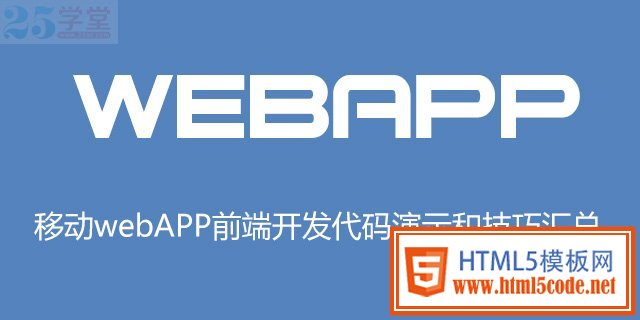下面是html5模版網(wǎng)(www.suosuyi.cn)收集了一些移動(dòng)webAPP前端開(kāi)發(fā)大牛們的經(jīng)驗(yàn)和技巧分享。
同時(shí)也是愛(ài)好webAPP前端開(kāi)發(fā)人員入門教程。另外html5模版網(wǎng)(www.suosuyi.cn)想告訴大家
“沒(méi)趕上Native app的,快抓緊Web app創(chuàng)業(yè)機(jī)會(huì)” 一起前行!教你如何從頭開(kāi)始創(chuàng)建一個(gè)可持續(xù)發(fā)展的Web APP應(yīng)用
1. viewport:webapp視圖
也就是可視區(qū)域。對(duì)于桌面瀏覽器,我們都很清楚viewport是什么,就是除去了所有工具欄、狀態(tài)欄、滾動(dòng)條等等之后用于看網(wǎng)頁(yè)的區(qū)域,
這是真正有效的區(qū)域。由于移動(dòng)設(shè)備屏幕寬度不同于傳統(tǒng)web,因此我們需要改變viewport;
實(shí)際上我們可以操作的屬性有4 個(gè):
width -???????????? //? viewport 的寬度 (范圍從200 到10,000,默認(rèn)為980 像素)height -??????????? //? viewport 的高度 (范圍從223 到10,000)initial-scale -???? //? 初始的縮放比例 (范圍從>0 到10)minimum-scale -??? //?? 允許用戶縮放到的最小比例maximum-scale -??? //?? 允許用戶縮放到的最大比例user-scalable -??? //?? 用戶是否可以手動(dòng)縮 (no,yes) |
那么到底這些設(shè)置如何讓Safari 知道?其實(shí)很簡(jiǎn)單,就一個(gè)meta,形如:
<meta http-equiv="Content-Type"?content="text/html; charset=utf-8">?? //編碼<meta id="viewport"?name="viewport"?content="width=320; initial-scale=1.0;maximum-scale=1.0; user-scalable=no;"/><meta name=”apple-mobile-web-app-capable” content=”yes” />? // 離線應(yīng)用的另一個(gè)技巧???? <meta name=”apple-mobile-web-app-status-bar-style” content=black” />? // 隱藏狀態(tài)欄??????? <meta content="black"?name="apple-mobile-web-app-status-bar-style"?/> //指定的iphone中safari頂端的狀態(tài)條的樣式??????? <meta content="telephone=no"?name="format-detection"?/>?????? //告訴設(shè)備忽略將頁(yè)面中的數(shù)字識(shí)別為電話號(hào)碼????? <meta name="Author"?contect="Mr.He"/ >? |
在設(shè)置了initial-scale=1 之后,我們終于可以以1:1 的比例進(jìn)行頁(yè)面設(shè)計(jì)了。關(guān)于viewport,還有一個(gè)很重要的概念是:iphone 的safari 瀏覽器完全沒(méi)有滾動(dòng)條,而且不是簡(jiǎn)單的“隱藏滾動(dòng)條”,是根本沒(méi)有這個(gè)功能。iphone 的safari 瀏覽器實(shí)際上從一開(kāi)始就完整顯示了這個(gè)網(wǎng)頁(yè),然后用viewport 查看其中的一部分。當(dāng)你用手指拖動(dòng)時(shí),其實(shí)拖的不是頁(yè)面,而是viewport。瀏覽器行為的改變不止是滾動(dòng)條,交互事件也跟普通桌面不一樣。
2.?link:對(duì)于樣式的鏈接和顯示
<link rel=”apple-touch-startup-image” href=”startup.png” /> // 設(shè)置開(kāi)始頁(yè)面圖片<link rel=”apple-touch-icon” href=”iphon_tetris_icon.png”/> // 在設(shè)置書(shū)簽的時(shí)候可以顯示好看的圖標(biāo)<link rel="stylesheet"?media="all and (orientation:portrait)"?href="portrait.css">??? // 肖像模式樣式?????? <link rel="stylesheet"?media="all and (orientation:landscape)"?href="landscape.css"???// 風(fēng)景模式樣式//豎屏?xí)r使用的樣式 <style media="all and (orientation:portrait)"?type="text/css">#landscape { display: none; }</style>//橫屏?xí)r使用的樣式 <style media="all and (orientation:landscape)"?type="text/css">#portrait { display: none; }</style>? |
3. 移動(dòng)端觸屏事件 :
// 手勢(shì)事件touchstart??????????? //當(dāng)手指接觸屏幕時(shí)觸發(fā)touchmove?????????? //當(dāng)已經(jīng)接觸屏幕的手指開(kāi)始移動(dòng)后觸發(fā)touchend???????????? //當(dāng)手指離開(kāi)屏幕時(shí)觸發(fā)touchcancel// 觸摸事件gesturestart????????? //當(dāng)兩個(gè)手指接觸屏幕時(shí)觸發(fā)gesturechange????? //當(dāng)兩個(gè)手指接觸屏幕后開(kāi)始移動(dòng)時(shí)觸發(fā)gestureend// 屏幕旋轉(zhuǎn)事件?? onorientationchange???? // 檢測(cè)觸摸屏幕的手指何時(shí)改變方向?????? orientationchange?????? // touch事件支持的相關(guān)屬性touches???????? targetTouches?????? changedTouches????????????? clientX // X coordinate of touch relative to the viewport (excludes scroll offset)?????? clientY // Y coordinate of touch relative to the viewport (excludes scroll offset)?????? screenX // Relative to the screen??????? screenY ? // Relative to the screen?????? pageX // Relative to the full page (includes scrolling)???? pageY // Relative to the full page (includes scrolling)???? target // Node the touch event originated from????? identifier ?? // An identifying number, unique to each touch event |
4.?屏幕旋轉(zhuǎn)事件:onorientationchange
添加屏幕旋轉(zhuǎn)事件偵聽(tīng),可隨時(shí)發(fā)現(xiàn)屏幕旋轉(zhuǎn)狀態(tài)(左旋、右旋還是沒(méi)旋)。例子:
// 判斷屏幕是否旋轉(zhuǎn)function?orientationChange() { ????switch(window.orientation) { ???? case?0:? ????????????alert("肖像模式 0,screen-width: "?+ screen.width + "; screen-height:"?+ screen.height); ????????????break; ???? case?-90:? ????????????alert("左旋 -90,screen-width: "?+ screen.width + "; screen-height:"?+ screen.height); ????????????break; ???? case?90:??? ????????????alert("右旋 90,screen-width: "?+ screen.width + "; screen-height:"?+ screen.height); ????????????break; ???? case?180:??? ???????? alert("風(fēng)景模式 180,screen-width: "?+ screen.width + "; screen-height:"?+ screen.height); ???????? break; ????};<br>};// 添加事件監(jiān)聽(tīng) addEventListener('load', function(){ ????orientationChange(); ????window.onorientationchange = orientationChange; }); |
5.?隱藏地址欄 & 處理事件的時(shí)候,防止?jié)L動(dòng)條出現(xiàn):
// 隱藏地址欄? & 處理事件的時(shí)候 ,防止?jié)L動(dòng)條出現(xiàn)addEventListener('load', function(){ ????????setTimeout(function(){ window.scrollTo(0, 1); }, 100); }); |
6.?雙手指滑動(dòng)事件:
// 雙手指滑動(dòng)事件addEventListener('load', function(){ window.onmousewheel = twoFingerScroll;}, ?????false??????????????// 兼容各瀏覽器,表示在冒泡階段調(diào)用事件處理程序 (true 捕獲階段)); function?twoFingerScroll(ev) { ????var?delta =ev.wheelDelta/120;????????????? //對(duì) delta 值進(jìn)行判斷(比如正負(fù)) ,而后執(zhí)行相應(yīng)操作 ????return?true; }; |
7. 判斷是否為iPhone:
// 判斷是否為 iPhone : function?isAppleMobile() { ????return?(navigator.platform.indexOf('iPad') != -1); }; |
8.?localStorage:
例子 :(注意數(shù)據(jù)名稱 ?n ?要用引號(hào)引起來(lái))
var?v = localStorage.getItem('n') ? localStorage.getItem('n') : "";?? // 如果名稱是? n 的數(shù)據(jù)存在 ,則將其讀出 ,賦予變量? v? 。 localStorage.setItem('n', v);?????????????????????????????????????????? // 寫(xiě)入名稱為 n、值為? v? 的數(shù)據(jù) localStorage.removeItem('n');?????????????????????????????????????????? // 刪除名稱為? n? 的數(shù)據(jù)??? |
9. 使用特殊鏈接:
如果你關(guān)閉自動(dòng)識(shí)別后 ,又希望某些電話號(hào)碼能夠鏈接到 iPhone 的撥號(hào)功能 ,那么可以通過(guò)這樣來(lái)聲明電話鏈接 ,
<a href="tel:12345654321">打電話給我</a> <a href="sms:12345654321">發(fā)短信</a> 或用于單元格: <td onclick="location.href='tel:122'">
10.?自動(dòng)大寫(xiě)與自動(dòng)修正
要關(guān)閉這兩項(xiàng)功能,可以通過(guò)autocapitalize 與autocorrect 這兩個(gè)選項(xiàng):
<input type="text" autocapitalize="off" autocorrect="off" />
移動(dòng)APP設(shè)計(jì)和webAPP設(shè)計(jì)中的六個(gè)小技巧
11.?WebKit CSS:
①“盒模型”的具體描述性質(zhì)的包圍盒塊內(nèi)容,包括邊界,填充等等。
-webkit-border-bottom-left-radius: radius; -webkit-border-top-left-radius: horizontal_radius vertical_radius; -webkit-border-radius: radius; //容器圓角 -webkit-box-sizing: sizing_model; 邊框常量值:border-box/content-box -webkit-box-shadow: hoff voff blur color; //容器陰影(參數(shù)分別為:水平X 方向偏移量;垂直Y 方向偏移量;高斯模糊半徑值;陰影顏色值) -webkit-margin-bottom-collapse: collapse_behavior; 常量值:collapse/discard/separate -webkit-margin-start: width; -webkit-padding-start: width; -webkit-border-image: url(borderimg.gif) 25 25 25 25 round/stretch round/stretch; -webkit-appearance: push-button; //內(nèi)置的CSS 表現(xiàn),暫時(shí)只支持push-button
②“視覺(jué)格式化模型”描述性質(zhì),確定了位置和大小的塊元素。
direction: rtl unicode-bidi: bidi-override; 常量:bidi-override/embed/normal
③“視覺(jué)效果”描述屬性,調(diào)整的視覺(jué)效果塊內(nèi)容,包括溢出行為,調(diào)整行為,能見(jiàn)度,動(dòng)畫(huà),變換,和過(guò)渡。
clip: rect(10px, 5px, 10px, 5px) resize: auto; 常量:auto/both/horizontal/none/vertical visibility: visible; 常量: collapse/hidden/visible -webkit-transition: opacity 1s linear; 動(dòng)畫(huà)效果 ease/linear/ease-in/ease-out/ease-in-out -webkit-backface-visibility: visibler; 常量:visible(默認(rèn)值)/hidden -webkit-box-reflect: right 1px; 鏡向反轉(zhuǎn) -webkit-box-reflect: below 4px -webkit-gradient(linear, left top, left bottom, from(transparent), color-stop(0.5, transparent), to(white)); -webkit-mask-image: -webkit-gradient(linear, left top, left bottom, from(rgba(0,0,0,1)), to(rgba(0,0,0,0)));; //CSS 遮罩/蒙板效果 -webkit-mask-attachment: fixed; 常量:fixed/scroll -webkit-perspective: value; 常量:none(默認(rèn)) -webkit-perspective-origin: left top; -webkit-transform: rotate(5deg); -webkit-transform-style: preserve-3d; 常量:flat/preserve-3d; (2D 與3D)
④“生成的內(nèi)容,自動(dòng)編號(hào),并列出”描述屬性,允許您更改內(nèi)容的一個(gè)組成部分,創(chuàng)建自動(dòng)編號(hào)的章節(jié)和標(biāo)題,和操縱的風(fēng)格清單的內(nèi)容。
content: “Item” counter(section) ” “; This resets the counter. First section >two section three section counter-increment: section 1; counter-reset: section;
⑤“分頁(yè)媒體”描述性能與外觀的屬性,控制印刷版本的網(wǎng)頁(yè),如分頁(yè)符的行為。
page-break-after: auto; 常量:always/auto/avoid/left/right page-break-before: auto; 常量:always/auto/avoid/left/right page-break-inside: auto; 常量:auto/avoid
⑥“顏色和背景”描述屬性控制背景下的塊級(jí)元素和顏色的文本內(nèi)容的組成部分。
-webkit-background-clip: content; 常量:border/content/padding/text -webkit-background-origin: padding; 常量:border/content/padding/text -webkit-background-size: 55px; 常量:length/length_x/length_y
⑦ “字型”的具體描述性質(zhì)的文字字體的選擇范圍內(nèi)的一個(gè)因素。報(bào)告還描述屬性用于下載字體定義。
unicode-range: U+00-FF, U+980-9FF;
⑧“文本”描述屬性的特定文字樣式,間距和自動(dòng)滾屏。
text-shadow: #00FFFC 10px 10px 5px; text-transform: capitalize; 常量:capitalize/lowercase/none/uppercase word-wrap: break-word; 常量:break-word/normal -webkit-marquee: right large infinite normal 10s; 常量:direction(方向) increment(迭代次數(shù)) repetition(重復(fù)) style(樣式) speed(速度); -webkit-marquee-direction: ahead/auto/backwards/down/forwards/left/reverse/right/up -webkit-marquee-incrementt: 1-n/infinite(無(wú)窮次) -webkit-marquee-speed: fast/normal/slow -webkit-marquee-style: alternate/none/scroll/slide -webkit-text-fill-color: #ff6600; 常量:capitalize, lowercase, none, uppercase -webkit-text-security: circle; 常量:circle/disc/none/square -webkit-text-size-adjust: none; 常量:auto/none; -webkit-text-stroke: 15px #fff; -webkit-line-break: after-white-space; 常量:normal/after-white-space -webkit-appearance: caps-lock-indicator; -webkit-nbsp-mode: space; 常量: normal/space -webkit-rtl-ordering: logical; 常量:visual/logical -webkit-user-drag: element; 常量:element/auto/none -webkit-user-modify: read- only; 常量:read-write-plaintext-only/read-write/read-only -webkit-user-select: text; 常量:text/auto/none
⑨“表格”描述的布局和設(shè)計(jì)性能表的具體內(nèi)容。
-webkit-border-horizontal-spacing: 2px; -webkit-border-vertical-spacing: 2px; -webkit-column-break-after: right; 常量:always/auto/avoid/left/right -webkit-column-break-before: right; 常量:always/auto/avoid/left/right –webkit-column-break-inside: logical; 常量:avoid/auto -webkit-column-count: 3; //分欄 -webkit-column-rule: 1px solid #fff; style:dashed,dotted,double,groove,hidden,inset,none,outset,ridge,solid
⑩“用戶界面”描述屬性,涉及到用戶界面元素在瀏覽器中,如滾動(dòng)文字區(qū),滾動(dòng)條,等等。報(bào)告還描述屬性,范圍以外的網(wǎng)頁(yè)內(nèi)容,如光標(biāo)的標(biāo)注樣式和顯示當(dāng)您按住觸摸觸摸
目標(biāo),如在iPhone上的鏈接。
-webkit-box-align: baseline,center,end,start,stretch 常量:baseline/center/end/start/stretch -webkit-box-direction: normal;常量:normal/reverse -webkit-box-flex: flex_valuet -webkit-box-flex-group: group_number -webkit-box-lines: multiple; 常量:multiple/single -webkit-box-ordinal-group: group_number -webkit-box-orient: block-axis; 常量:block-axis/horizontal/inline-axis/vertical/orientation –webkit-box-pack: alignment; 常量:center/end/justify/start
12.?動(dòng)畫(huà)過(guò)渡
這是 Webkit 中最具創(chuàng)新力的特性:使用過(guò)渡函數(shù)定義動(dòng)畫(huà)。
-webkit-animation: title infinite ease-in-out 3s; animation 有這幾個(gè)屬性: -webkit-animation-name: //屬性名,就是我們定義的keyframes -webkit-animation-duration:3s //持續(xù)時(shí)間 -webkit-animation-timing-function: //過(guò)渡類型:ease/ linear(線性) /ease-in(慢到快)/ease-out(快到慢) /ease-in-out(慢到快再到慢) /cubic-bezier -webkit-animation-delay:10ms //動(dòng)畫(huà)延遲(默認(rèn)0) -webkit-animation-iteration-count: //循環(huán)次數(shù)(默認(rèn)1),infinite 為無(wú)限 -webkit-animation-direction: //動(dòng)畫(huà)方式:normal(默認(rèn) 正向播放); alternate(交替方向,第偶數(shù)次正向播放,第奇數(shù)次反向播放)
這些同樣是可以簡(jiǎn)寫(xiě)的。但真正讓我覺(jué)的很爽的是keyframes,它能定義一個(gè)動(dòng)畫(huà)的轉(zhuǎn)變過(guò)程供調(diào)用,過(guò)程為0%到100%或from(0%)到to(100%)。簡(jiǎn)單點(diǎn)說(shuō),只要你有想法,你想讓元素在這個(gè)過(guò)程中以什么樣的方式改變都是很簡(jiǎn)單的。
-webkit-transform: 類型(縮放scale/旋轉(zhuǎn)rotate/傾斜skew/位移translate) scale(num,num) 放大倍率。scaleX 和 scaleY(3),可以簡(jiǎn)寫(xiě)為:scale(* , *) rotate(*deg) 轉(zhuǎn)動(dòng)角度。rotateX 和 rotateY,可以簡(jiǎn)寫(xiě)為:rotate(* , *) Skew(*deg) 傾斜角度。skewX 和skewY,可簡(jiǎn)寫(xiě)為:skew(* , *) translate(*,*) 坐標(biāo)移動(dòng)。translateX 和translateY,可簡(jiǎn)寫(xiě)為:translate(* , *)。
實(shí)現(xiàn)模擬彈出消息框(Alert)的例子:
①定義過(guò)渡(在<style type=”text/css”>段中描述keyframes):
@-webkit-keyframes DivZoom
{
0% { -webkit-transform: scale(0.01) }
60% { -webkit-transform: scale(1.05) }
80% { -webkit-transform: scale(0.95) }
100% { -webkit-transform: scale(1.00) }
}
.sZoom { -webkit-animation: DivZoom 0.5s ease-in-out }
(很容易看懂,將元素從縮小的0.01 倍–很小但不能為0 倍,放大到1.05 倍,再縮小到0.95倍,最后到1 倍即正常大小。整個(gè)過(guò)渡過(guò)程事件為0.5 秒,動(dòng)畫(huà)方式為ease-in-out,即慢到快再到慢,默認(rèn)只進(jìn)行1 次過(guò)渡。這正是大家經(jīng)常看到的 iPhone 彈出的提示信息的動(dòng)畫(huà)效果!)
②定義元素(在<body>段中):
<div id="layerH" style="-webkit-border-radius:12px; border:2px solid #FFF;-webkit-box-shadow: 0px 2px 4px #888;position: absolute; left: 24px; top: 106px;
width: 256px; height: 268px; padding-left: 8px; padding-right: 8px;color: #FFFFFF; text-shadow: 1px 1px 1px #000; text-align: center;background-color: RGBA(32,48,96,0.9);
background-image:url('BG-Msg.png'); background-repeat:no-repeat;
z-index: 1; visibility: hidden; ">
<p><span style="font-size: 16pt; font-weight: bold">使用說(shuō)明</span></p>
<hr noshade size="1">
<div id="HelpText" style="height: 120px">說(shuō)明文字</div>
<hr noshade size="1">
<form name="formV" method="POST">
<input type="button" value="確認(rèn)" name="B1"
style="width: 100%; height: 40px; font-size: 14pt; ont-weight: bold;
color: #FFFFFF; text-shadow: 0px -1px 1px #000;"
onclick=" layerH.style.visibility='hidden'">
</form>
</div>
③啟動(dòng)動(dòng)畫(huà)(在 javascript 定義的函數(shù)中)
function pHelp()
{
layerH.style.visibility = 'visible'
layerH.style.cssText = "-webkit-animation-delay: " + Math.random() + "ms"
layerH.className = 'sZoom'
}
(這個(gè)啟動(dòng)函數(shù)就很好理解了。但是為什么要使用-webkit-animation-delay 這句呢?因?yàn)楫?dāng)一個(gè)元素過(guò)渡顯示完成后,若其樣式?jīng)]有變化,下一次將無(wú)法進(jìn)行過(guò)渡動(dòng)畫(huà)顯示。我們巧妙的利用其動(dòng)畫(huà)延遲時(shí)間定義,使其有所變化,就避免了上述問(wèn)題。其中使用隨機(jī)數(shù)函數(shù)Math.random(),產(chǎn)生一個(gè)大于0 小于1 的隨機(jī)數(shù)。當(dāng)然,延遲零點(diǎn)幾毫秒,用戶是不會(huì)察覺(jué)的。)
webAPP開(kāi)發(fā)知識(shí)補(bǔ)充:
1.?鎖定 viewport
ontouchmove="event.preventDefault()" //鎖定viewport,任何屏幕操作不移動(dòng)用戶界面(彈出鍵盤(pán)除外)。
2.?被點(diǎn)擊元素的外觀變化,可以使用樣式來(lái)設(shè)定:
-webkit-tap-highlight-color: 顏色
3.?偵測(cè)iPhone/iPod
開(kāi)發(fā)特定設(shè)備的移動(dòng)網(wǎng)站,首先要做的就是設(shè)備偵測(cè)了。下面是使用Javascript偵測(cè)iPhone/iPod的UA,然后轉(zhuǎn)向到專屬的URL。
if((navigator.userAgent.match(/iPhone/i)) || (navigator.userAgent.match(/iPod/i))) {
if (document.cookie.indexOf("iphone_redirect=false") == -1) {
window.location = "http://m.example.com";
}
}
雖然Javascript是可以在水果設(shè)備上運(yùn)行的,但是用戶還是可以禁用。它也會(huì)造成客戶端刷新和額外的數(shù)據(jù)傳輸,所以下面是服務(wù)器端偵測(cè)和轉(zhuǎn)向:
if(strstr($_SERVER['HTTP_USER_AGENT'],'iPhone') || strstr($_SERVER['HTTP_USER_AGENT'],'iPod')) {
header('Location: http://yoursite.com/iphone');
exit();
}
4.?阻止旋轉(zhuǎn)屏幕時(shí)自動(dòng)調(diào)整字體大小
html, body, form, fieldset, p, div, h1, h2, h3, h4, h5, h6 {-webkit-text-size-adjust:none;}
5.?iPhone才識(shí)別的CSS
如果不想設(shè)備偵測(cè),可以用CSS媒體查詢來(lái)專為iPhone/iPod定義樣式。
@media screen and (max-device-width: 480px) {}
6.?縮小圖片
網(wǎng)站的大圖通常寬度都超過(guò)480像素,如果用前面的代碼限制了縮放,這些圖片在iPhone版顯示顯然會(huì)超過(guò)屏幕。好在iPhone機(jī)能還夠,我們可以用CSS讓iPhone自動(dòng)將大圖片縮小顯示。
@media screen and (max-device-width: 480px){
img{max-width:100%;height:auto;}
}
7.?模擬:hover偽類
因?yàn)閕Phone并沒(méi)有鼠標(biāo)指針,所以沒(méi)有hover事件。那么CSS :hover偽類就沒(méi)用了。但是iPhone有Touch事件,onTouchStart 類似 onMouseOver,onTouchEnd 類似 onMouseOut。所以我們可以用它來(lái)模擬hover。使用Javascript:
var myLinks = document.getElementsByTagName('a');
for(var i = 0; i < myLinks.length; i++){
myLinks[i].addEventListener(’touchstart’, function(){this.className = “hover”;}, false);
myLinks[i].addEventListener(’touchend’, function(){this.className = “”;}, false);
}
然后用CSS增加hover效果:
a:hover, a.hover { /* 你的hover效果 */ }
這樣設(shè)計(jì)一個(gè)鏈接,感覺(jué)可以更像按鈕。并且,這個(gè)模擬可以用在任何元素上。移動(dòng)APP設(shè)計(jì)和webAPP設(shè)計(jì)中的六個(gè)小技巧和WebAPP設(shè)計(jì)和入門開(kāi)發(fā)需要注意的5個(gè)事項(xiàng)

